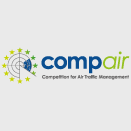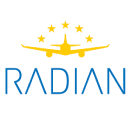

Aviation is the practical aspect or art of aeronautics, being the design, development, production, operation, and use of aircraft, especially heavier- than-air aircraft. The word "aviation" was coined by French writer and former naval officer Gabriel La Landelle in 1873, from the verb "avier" (synonymous flying), itself derived from the Latin word "avis" ("bird") and the suffix "-ation".
The modern age of aviation began with the first untethered human lighter-than- air flight on November 21, 1783 of a hot air balloon designed by the Montgolfier brothers.
Rigid airships became the first aircraft to transport passengers and cargo over great distances. The German Zeppelin company manufactured the best-known aircraft of this type.
The Wright brothers were the first to fly in a powered and controlled aircraft. Previous flights were gliders (control but no power) or free flight (power but no control), but the Wright brothers combined both, setting the new standard in aviation records. Following this, the widespread adoption of ailerons rather than wing warping made aircraft much easier to control, and only a decade later, at the start of World War I, heavier-than-air powered aircraft had become practical for reconnaissance, artillery spotting, and even attacks against ground positions.
During the 1920s and 1930s, great progress was made in the field of aviation, including the first transatlantic flight of Alcock and Brown in 1919, Charles Lindbergh's solo transatlantic flight in 1927, and Charles Kingsford Smith's transpacific flight the following year. One of the most successful designs of this period was the Douglas DC-3, which became the first airliner to be profitable carrying passengers exclusively, starting the modern era of passenger airline service. By the beginning of World War II, many towns and cities had built airports, and there were numerous qualified pilots available. The war brought many innovations to aviation, including the first jet aircraft and the first liquid- fuelled rockets.
After World War II, especially in North America, there was a boom in general aviation, both private and commercial, as thousands of pilots were released from military service and many inexpensive war-surplus transport and training aircraft became available. Manufacturers such as Cessna, Piper, and Beechcraft expanded production to provide light aircraft for the new middle-class market. By the 1950s, the development of civil jets grew, beginning with the de Havilland Comet, though the first widely used passenger jet was the Boeing 707, because it was much more economical than other aircraft at that time. At the same time, turboprop propulsion began to appear for smaller commuter planes, making it possible to serve small-volume routes in a much wider range of weather conditions.
Since the 1960s, composite material airframes and quieter, more efficient engines have become available, and Concorde provided supersonic passenger service for more than two decades, but the most important lasting innovations have taken place in instrumentation and control. The arrival of solid-state electronics, the Global Positioning System, satellite communications, and increasingly small and powerful computers and LED displays, have dramatically changed the cockpits of airliners and, increasingly, of smaller aircraft as well. Pilots can navigate much more accurately and view terrain, obstructions, and other nearby aircraft on a map or through synthetic vision, even at night or in low visibility.
On June 21, 2004, SpaceShipOne became the first privately funded aircraft to make a spaceflight, opening the possibility of an aviation market capable of leaving the Earth's atmosphere. Meanwhile, flying prototypes of aircraft powered by alternative fuels, such as ethanol, electricity, and even solar energy, are becoming more common.

The Airport Information System (AIS) developed by Slot Consulting aims to provide a framework for airport communication processes. The system can be used for the following reasons:... Read more...

A Slot Consulting Kft. volt az egyik nyertese a KMOP-2009-1.1.4 pályázatnak, a Gazdaságfejlesztési Operatív Program és Közép-Magyarországi Operatív vállalati innováció támogatása tárgyú pályázati konstrukcióban, 'Integrált Teljesítményelemző És Repüléstervező Információs Rendszer Kisrepülőgépek Szám... Read more...

Budapest 2.0 is a demonstration project launched by the SESAR Joint Undertaking. Slot Consulting is a consortium member in the project contributing to the activities of HungaroControl.... Read more...

Air transport is facing many challenges such as increasing demand, larger airports, increased network congestion, etc. which also need to be reconciled with environmental issues. Hence there is a need for smarter solutions at service, operational and technical level.... Read more...

Aviation is a vital industrial sector of Europe's society and economy. For several historical reasons the economic activities in this field are unevenly distributed across Europe. Statistics show that also the R&D effort, which always comes along with the aviation, mirrors this allocation. O... Read more...